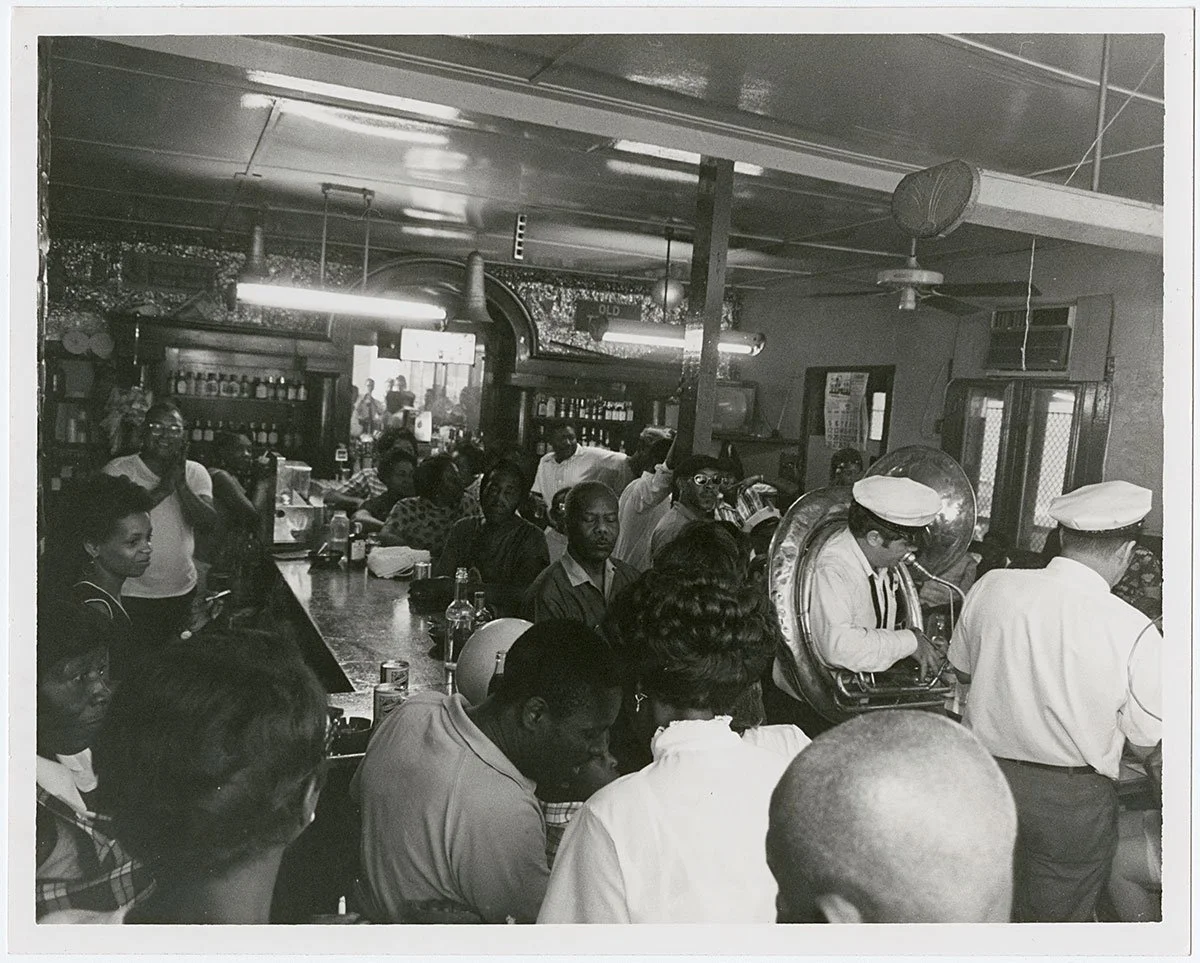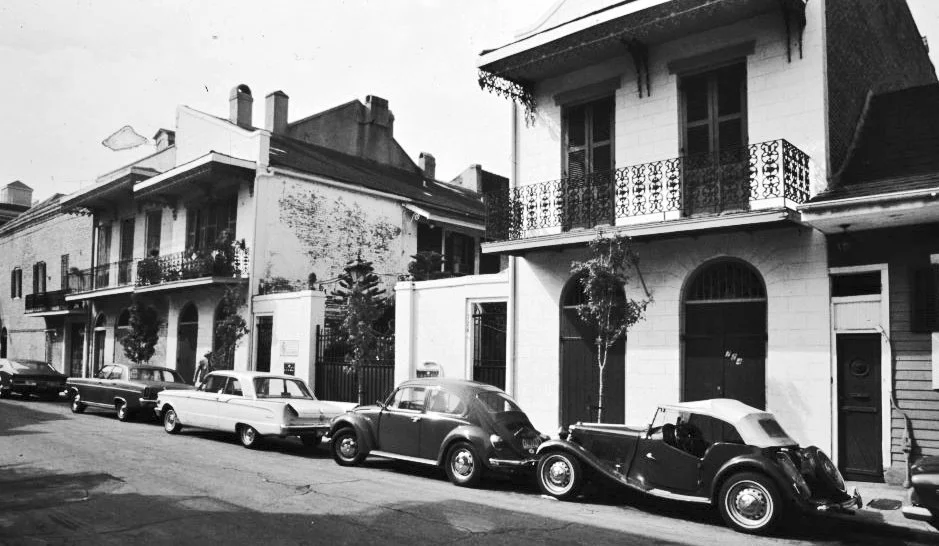Batou Chandler: Always a Quarter Kid
Batou Chandler in her Royal Street home, photo by Ellis Anderson
July 2025Decades may pass, but if you grew up in the French Quarter, it will always lead you home.
~ by Batou Chandler
The Quarter Kaleidoscope series of published stories is underwritten in part by:
This project is made possible in part by a grant from the New Orleans Jazz & Heritage Foundation, Inc.
This project is underwritten in part by Kelly & Linda Baker
I grew up in the 700th block of Governor Nicholls Street, Lower Quarter, Sixth Ward. I’m a Quarter kid.
I’ve lived all over the world, I have dual French and American citizenship and am by now, many decades past where anyone would call me a kid. But my true nationality and identity is and has always been: Quarter kid.
Patricia, David, Jean & Batou Chandler at home, Spanish Stables, early 1970s, courtesy Batou Chandler
Batou with her mother Patricia at Galatoire’s, 1984, courtesy Batou Chandler
I grew up in the 70s and 80s, as the city was coming into its own, post-segregation. I was lucky enough to go to McDonough 15, a sort of non-linear Hogwarts, French Quarter style. It was a place deeply steeped in magic – just more of the musical and social justice variety. Walter Payton was our professor Dumbledore. The experience was both weird and fabulous.
The McDonough 15 Band, led by Walter Payton. Batou is the youngest blond flute player facing the camera. Photo courtesy Batou Chandler
When school dismissed each day, most kids would pile into school buses and cars. But there were about 15 to 20 of us Quarter kids, and we would hit the streets – running around, marauding, hitting parks and a lot of shops and charming very patient shopkeepers. Sometimes we traveled in groups or with siblings but sometimes solo, too. Everyone looked out for the kids in the neighborhood, so it felt safe to amble.
On my street alone, we had Ms. Josie and Ms. Shell, who ran the Verti Marte, and Mr. Ferara at the fish market, who always had the best stories.
Brocato's was around the corner (where Croissant D’or is now), and when the strawberries were in season, you could smell them at the shop from blocks away. We would tear over there like lunatics, and Mrs. Brocato would let us help stir in the strawberries, making the Italian ice.
The Brocato’s building at 615/617 Ursulines, 1975. Courtesy the Vieux Carré Commission Virtual Library.
Joan Good on Royal had the most beautiful jewelry and objets d’arts. She would often have a friend there with horse racing forms. The two would look over the upcoming races, and he would go place her bets.
Joan Good’s shop was on the left side of 809/811 Royal Street for four decades. Photo 1975, courtesy the Vieux Carré Commission Virtual Library.
A block from there was Carmencita, who owned Suarez on Dumaine and Chartres, a dreamy fancy soap and lotions shop. She would let me help wrap the beautiful French boxes in cellophane and tie silk ribbons around them.
Carmancita would teach me the “proper way” to apply perfume: spray the air and walk through the scent so that it just wafts over you – probably just a clever way to keep a young girl from smelling like a brothel.
Carmancita owned the shop Suarez at the corner of Dumaine and Chartres Street, 839 Chartres. Photo 1988, courtesy the Vieux Carré Commission Virtual Library.
Buster Holmes reigned as king of the Quarter. We loved to eat in his restaurant or sit at the counter drinking a Barq’s, and beg him and other locals to tell stories. At the French Market, I would walk past endless stalls brimming with fresh local produce but also full of exotic fruits arriving on the river.
Interior of Buster Holmes, 1970, by Jules Cahn, courtesy Jules Cahn Collection at the Historic New Orleans Collection, 2000.78.1.1677
In the fall, I would find local vegetables both familiar and strange. At sugarcane harvest time, Mr. Bobby would keep icy stalks of sugar cane and let us chew on them, sucking out all the sweetness as he told us stories about his Merchant Marine sailing adventures.
The French Market, 1975, courtesy the Vieux Carré Commission Virtual Library.
As a young teen in the late 1980s, almost all of the money I earned went directly to a teenage trifecta: Bongo, Tower Records and Canal Place. They made a treacherous retail corridor along the river that my teen self could not resist.
In the late and steamy summer of 1989, I walked out of Canal Place where I saw “Do the Right Thing,” and hit a sale at Bongo. The iconic new wave/punk rock store which had been in the Lower Quarter for ages, was at its last home on upper Decatur, brimming with clothes, records, punk rock t-shirts, leather jackets and platform boots.
They were so badass their phone number was 523-ROCK. To me, at age 17, they were the ultimate.
I grabbed a few shirts at the sale and was heading to La Madeleine in the Pontalba building [where Stanley’s is now] for a chicken Ceasar salad – very glamorous. I was trying to cram in all my favorite things because soon, I was leaving to head to NYU Tisch to start college.
The later location of La Madeleine’s in the Pontalba building, corner of St. Ann and Chartres - the current location of Stanley’s. This photograph was taken in 1978, courtesy the Vieux Carré Commission Virtual Library.
I was listening to my Walkman as I walked through the Square, absorbed in my music, carrying my shopping bags. Both sides of the Pontalba were engulfed in a massive renovation, with scaffolding in every direction.
As I walked past the Cathedral, something altered. Like a stutter in time. The music in my earphones went slow-mo. It was “Express Yourself” and Madonna got very slow.
I stopped frozen about 25 feet from the front of La Madeleine. It was like looking at a Dalí, where everything was melting. Inside the cafe, a bunch of people were running out of the side door onto Chartres.
And then, directly in front of me, a man in a wheelchair, screaming at me, barreled right for me – but with no sound coming out of his mouth. I only realized later that I couldn’t hear him because I was still listening to music on my Walkman.
This man and his wheelchair crashed into me, undoubtedly saving my life as we both went flying through the air. We fell to the ground just as the facade of the building collapsed around us – along with all the scaffolding.
As we were still airborne from his crashing into me, it seemed certain we would be buried alive or crushed to death. In that moment, I realized he had seen me and chosen to endanger himself to save my dumb ass. The man had been screaming at me to run, but my earphones – and shock at what I was seeing – had blocked the sound.
In the aftermath, we looked like escapees from Pompeii, covered in rubble and concrete dust, as did the entire square in front of us. There were people surrounding us immediately helping us, asking if we were okay – and surprisingly, we were. But in shock, I lurched away from everyone and ran away sobbing.
I naturally drew the attention of my neighbors and shopkeepers who were trying to stop me and offer their help. I stopped running and walked, occasionally glancing back at the group of friends and acquaintances now following me, providing comfort and protection all the way to my front gates.
The old Spanish Stables on Gov. Nicholls Street, 1975, where Batou grew up, courtesy the Vieux Carré Commission Virtual Library.
The interior courtyard of the Old Spanish Stables in 1982, where Batou and her family lived, courtesy the Vieux Carré Commission Virtual Library.
Once I was inside, it was already hitting the news that most of the facade was intact on the Pontalba, and it was principally the scaffolding that had collapsed. No one had been hurt.
Goddamn miracle that, even in spite of doing mostly everything wrong, I still survived the disaster – a testament to how a community cares for each other.
That evening, Roland, our landlord, served peaches soaked in red wine, a dish he knew I loved. The adults drank wine, and I got tipsy on peaches. Later, my mother and I watched the news of what had happened. Seeing the destruction on television, I was amazed that I somehow walked away basically unscathed.
Later in my bedroom, I thought about the events of the day – of the man in the wheelchair whom I never got to thank, or the half dozen people who followed me home. I felt deeply connected and deeply grateful. I came from a place where I so deeply belonged, the community was part of my soul.
And my courage was bolstered. I felt more prepared to take on the challenges of moving to New York and starting school. The entire experience felt like a hug from the Quarter, affirming our love and devotion to each other as I prepared for my new adventure. I understood that no matter where I may go and the roads I may take, the Quarter would lead me home.
Batou Chandler and Lily Sacabo Wonk in the 1980s, photograph by Josephine Sacabo at the Spanish Stables apartment of Dalt Wonk and Josephine Sacabo, courtesy Batou Chandler and Josephine Sacabo















